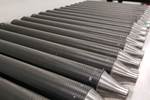Rock West sandwich panels support high-power Astro Digital satellites
RWC built and delivered solar array substrate panels from trace/lead-integrated skins that enable direct integration with solar cells, saving weight and time.
Final SAS panels. Source | Rock West Composites
Rock West Composites (RWC, San Diego, Calif., U.S.) announces the delivery of panels for ’s (Santa Clara) 500-watt arrays to support higher power versions of its Corvus buses. RWC teamed with Astro Digital to fabricate solar array substrate (SAS) panels with a distinctive integrated design to save volume and weight. These panels are being integrated into space vehicles, the first of which is scheduled to launch in October.
RWC built the SAS sandwich panels from trace/lead integrated-skins that enabled direct integration with solar cells. This reduced total weight and shortened the integration time. The customer furnished the G10 (fiberglass) skins that already had the integrated copper traces. RWC used specialized tooling to align the face skins on the aluminum honeycomb core to keep the traces in the right location during fabrication of the approximately 2 × 2-foot structures.
“This is a great example of how we can help our customers solve their problems in innovative ways,” says Jeremy Senne, space segment director. “It was a tooling and machining challenge to work with their pre-integrated skins, but our experience on other precision programs enabled successful fabrication.”
Related Content
-
Rocket Lab begins installation of large AFP machine for rocket production
The 99-ton AFP machine, custom-designed and built by Electroimpact, is claimed to be the largest of its kind, expecting to save around 150,000 manufacturing hours in the Neutron rocket’s production process.
-
Call for abstracts: CW Tech Days to explore high-temperature composite solutions
The fall 2025 installment of CW’s Tech Days online event series will cover high-temperature composite solutions for defense and space applications.
-
Expanding high-temperature composites in India and the U.S.
Azista USA offers polymers and processes for carbon/carbon and other CMC, including novel hot-melt phenolic and phthalonitrile prepregs for faster cycle times, alternative solutions.



